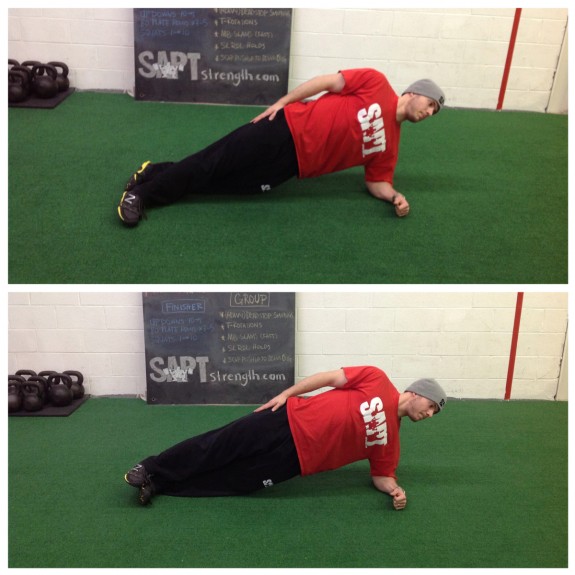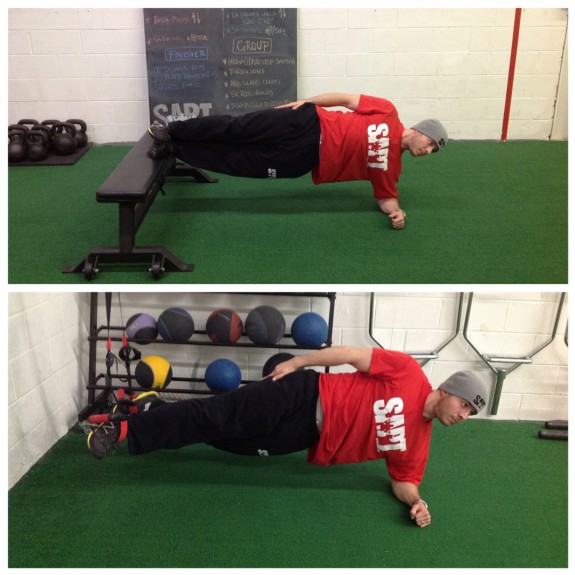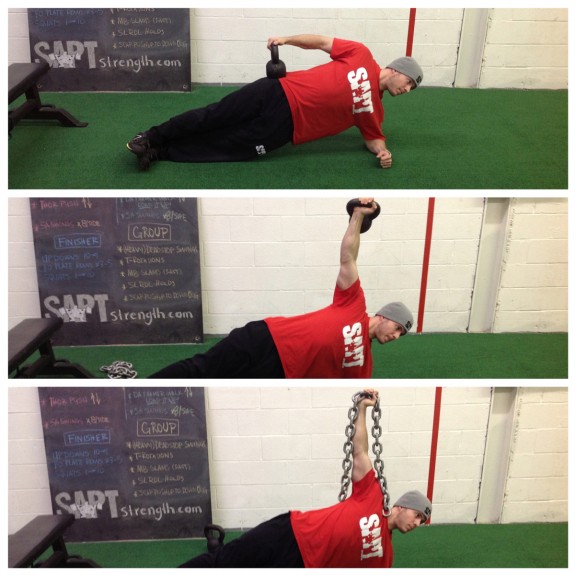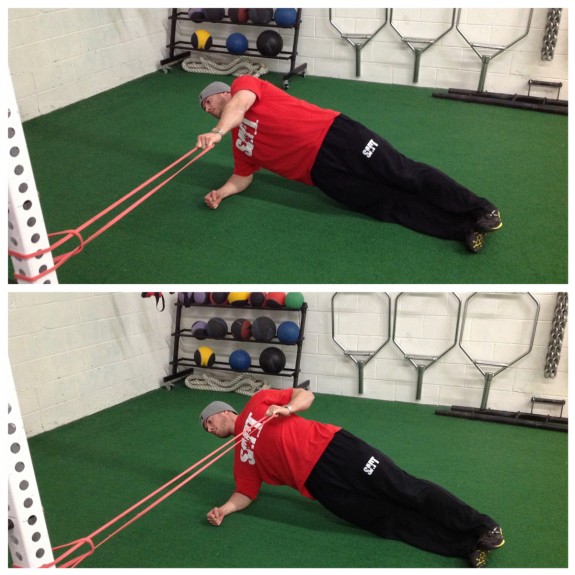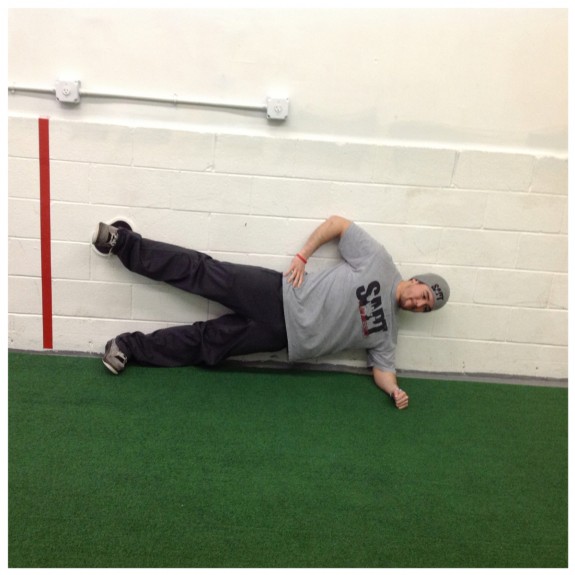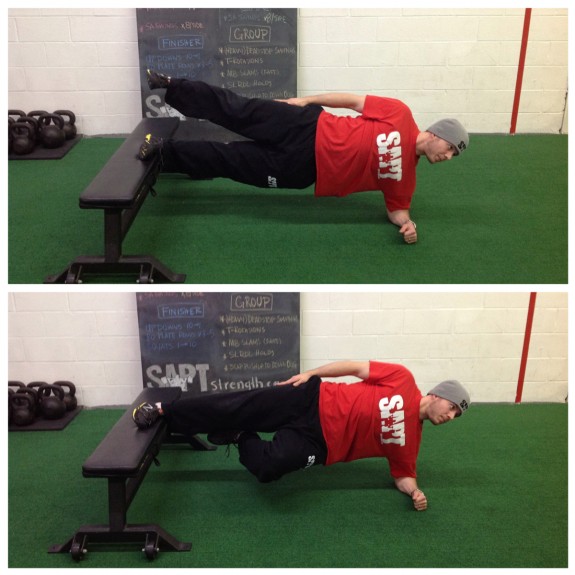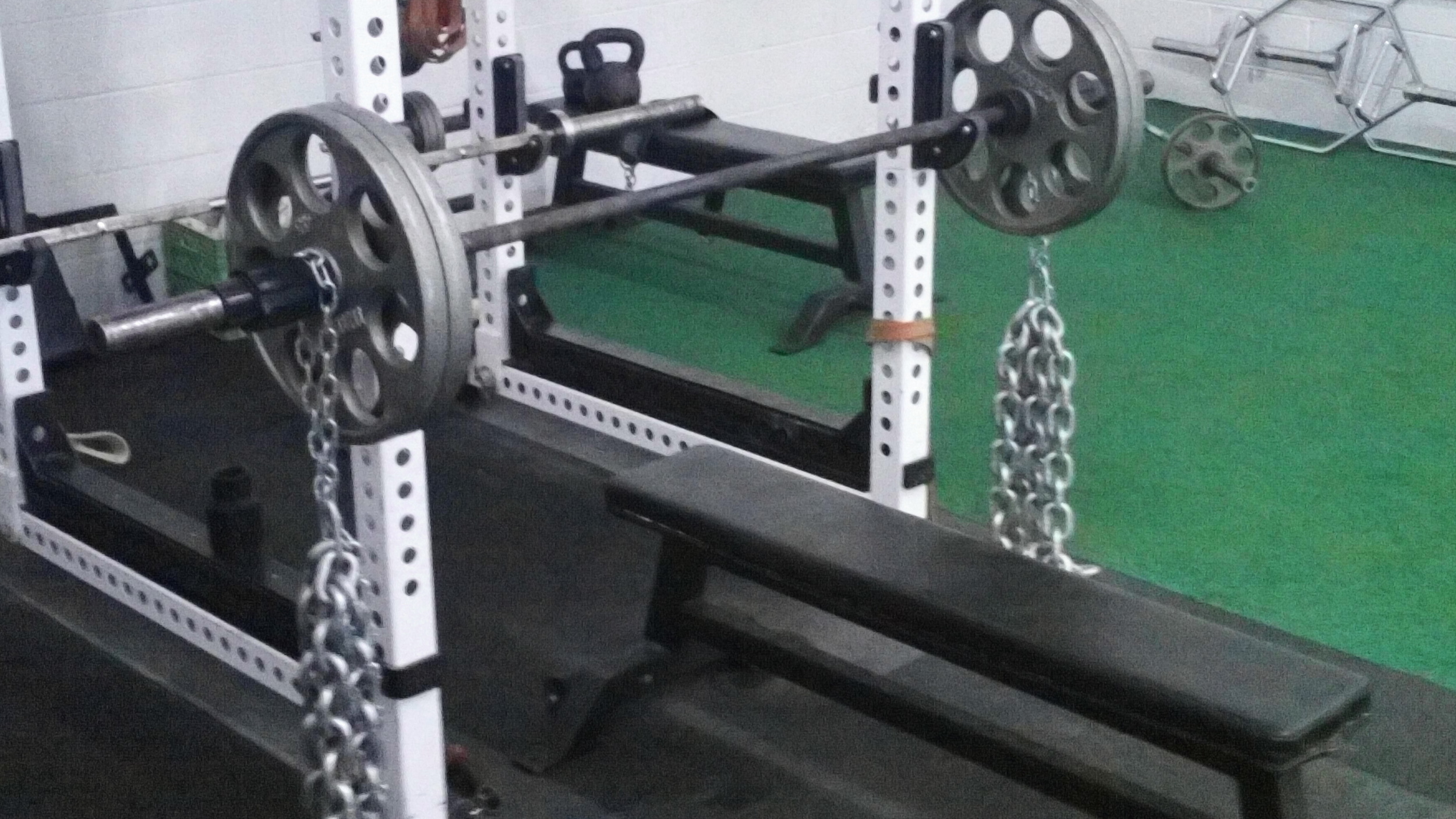Some SAPT Video Highlights: Post-Rehab Deadlifts, 1,000lb Prowler Drags, Pistol Shenanigans, and More
I have a number of topics I'd like to write about, but they'll have to remain on the back burner for a little while due a few pressing deadlines occupying my time. I know a few of you are waiting for me to do a Q & A based on a few email questions that have been sent my way; I'll be getting to those soon, I promise. In the meantime, hope you enjoy!
1. The other evening, I was shootin' the breeze with a couple of our interns, when the topic of pistol squats became infused into our dialogue.
I made a sarcastic comment to Chavez, along the lines of "Hey, why don't you try a pistol squat to a box jump, I think that'd be really easy." (Translation: I can think of a thousand activities that would be safer than attempting a pistol squat to box jump, one of which being throwing yourself into a lion's den with a T-bone strapped to your face, and another being hopping into a live volcano.)
Well, next time I'll learn to hold my tongue, as apparently Chavez doesn't back down from a challenge, no matter how outrageous it may be:
2. Many of you know Conrad from this story that Coach Tadashi wrote up on Conrad entering his first powerlifting meet just a couple months out of his second total knee replacement surgery. (Mind you, the two operations took place within a year of each other.)
Well, we have been continuing to help him along with his post-rehab training, and needless to say he has been doing spectacular, along with recently celebrating his 65th birthday to boot.
Just this past week he hit a 2-rep deadlift at 225lbs + 60lbs chains, so, using our arithmetic skills, that gives him 285lbs at the top of his pull. As you can see, he still had PLENTY of room in the tank to spare. Good stuff!!!
He's come a long way with his deadlift technique over the past few months. Sure, he could extend his T-spine slightly more, and pack the neck, but I give him three green lights for the time being.
3. One of our prior high school athletes, Carson, has been enrolled in our Distance Coaching Program since he left for college last Fall. Throughout his first 12-week distance training cycle with SAPT, he added an impressive 35lbs to his prior deadlift max (410lbs).
Here he is ripping a solid 445 pounds off the ground. I'm saying he'll have 500lbs in his grasp well before he graduates college!
Way to go, Carson.
4. Big Joe - even though he's an "endurance athlete" - finds anything involving heavy weights, or a challenging task, unconditionally palatable. Mix the two together and you get a 1,000lb Prowler Forward Drag by Big Joe from last Saturday morning:
Strong!
5. Here is Sheik, a cat who resides in the same dwelling as Kelsey and I. The other day, she insisted on refusing to allow any Hershey's kiss to remain alive while she still walked the Earth. She inexorably hunted down and destroyed them all, no matter how many continued to slide across the table in their efforts to pass her by.
That's all for now. Hope everyone has a great weekend!
The Reverse Band Bench Press and How to Know How Much Help You Receive from the Bands
Given there are a bevy of variables affecting the amount of assistance you receive from the bands in a reverse band bench press - the thickness of the band, how high above the bar the bands are attached, how many times the bands are looped around, how old the bands are, to name a few - one of the most common questions among people looking to reverse bench for the first time is, "I have know idea how much the bands are helping me....so where do I start poundage-wise for X number of sets and reps?"
See the video below to find out:
The reverse band bench press is a fantastic tool that I like to employ for four primary purposes:
1. As alluded to in the video above, there is less eccentric stress compared to a normal bench press - and way less eccentric stress compared to a bench press against bands - during the lift due to the fact that the bands are pulling in the opposite direction of gravity. In general, this makes it much more shoulder and elbow friendly, and it also doesn't "tax" your body and central nervous system as much as a normal bench press would.
2. Because of point #1, the movement tends to be a bit easier on the joints. As such, I've been using it more and more with some of our athletes that either have shoulder pain, or are coming off of a surgery or rehab program.
3. It teaches the lifter to actively row, or pull, the bar down to him or her. One of the most common flaws I see in amateur lifters is failing to do just that, and it's a technique I discussed in further detail in THIS post; basically, it's going to engage the upper back more (always a good thing) and give you a more stable platform to press out of in the bottom. How you enter the tunnel affects how you exit the tunnel, if you will.
4. It helps improve the top half of your bench. Since the bands provide less assistance as you press up (the band becomes more slack) you are responsible for lifting a greater percentage of actual bar weight toward the end range of the lift.
There are a number of other reasons one would use it during a training cycle, but I'll cut it there for now.
Oh, and I believe this goes without saying but, be very careful when loading and unloading the bar when it's hanging from the bands. Things can get very chaotic really quickly if you're not careful.
For the Overextended Part II
A few months ago I wrote a post on warming up for those with a chronically overextended lumbar spine. Since then I’ve gotten a few requests for a sequel post, so... Without further adieu…
For the Overextended Part II: The Lift
In my first post I discussed “prepping” for the lift for those with exaggerated lordosis. I babbled about targeted stretching, mobilizing, and activation exercises used in conjunction with the idea that it would help “tuck” the hips under a bit more and reduce that ridiculous curve in the lower back that ails us.
For many that'll do the trick. After the warm-up they can feel their abs and glutes engage a bit more throughout their lifting session and they feel much more secure about their lower back health.
However, there are those that need more than a 15 minute warm-up to relieve them of their discomfort caused by the overextension. These might be the people with hip flexors that refuse to let go, erectors in constant spasm, and glutes that seem to have tragically passed away from years of desk work.
For these people with symptoms a bit more severe than the rest, some careful consideration should be taken into not only their warm-up but the structure of the lifting program itself. Here are a few exercises I like to use to fight against the overextension apocalypse.
Lower Body
Front Squats
For improved posture I tend to favor front squats over back squats mainly because it really helps to emphasize t-spine extension. Like I mentioned in my previous post, a hyperlordodic posture is often accompanied by significant kyphosis in the upper back. By focusing on keeping the upper back tight and the elbows up and in, front squats basically become a good way to practice good posture under resistance. (Practice makes permanent!)
Split Squats
Remember to do your split squats with all of the knee health rules in mind (keep the knee tracking straight ahead, try to keep a vertical shin), but add this one: squeeze the glute of your rear leg HARD the entire time. If you really flex that rear buttcheek you will feel a good stretch in that hip flexor as you descend to the bottom position.
Pull-Throughs and Glute Bridges
Keep hammering away at your posterior chain strength and emphasize the “tuck under” with your hips. Pull-throughs with a band or cable column is a great way to train the backside while avoiding any compression on your spine. Also throw in some glute bridges into your actual lift! They shouldn’t be reserved for just the warm-up.
Glute bridging variations are endless:
-Double Leg -Single Leg -Double Leg Concentric with Single Leg Eccentric -With a Barbell -With Chains -With a Barbell AND Chains -Back Elevated -Feet Elevated -Back AND Feet Elevated
Get to 'em!
KB Swings
Same idea as above: POSTERIOR CHAIN WORK. Perfect the hinge and develop incredible hip thrusting power. I recommend getting Kelsey or another well-qualified coach to supervise if you haven’t done them before. A correctly performed swing session can do wonders for your posture, but a bad swing sesh can wreak havoc on your lower back!
Upper Body
½ Kneeling Work
Do standing overhead presses and barbell rows make your lower back cranky? Fear not, and enter the ½ kneeling realm of pushing and pulling. Getting into the ½ kneeling position does a great job of positioning overextended spines back to neutral. Replace some of your pressing movements with single arm ½ kneeling landmine, kettlebell, or dumbbell presses. Then make sure to get your pulling in and grab a band or a cable column to do some ½ kneeling rows as well.
Push-Ups and Inverted Rows
Easy enough right? If you take away the movement from the upper extremities, these exercises become a plank or an isometric glute bridge, respectively. What I mean by that is you MUST make sure you keep your abs tight and your hips (NOT lower back) locked in extension as you do your push-ups and rows. When you feel like you’re starting to arch, call it a set or reset your hips.
Benching…?
Bench pressing can help improve my overextended posture?! No, I doubt it. However, I’m throwing it on here for a couple reasons 1) A lot of us are probably going to bench anyway. 2) It may be part of your team’s strength program for high school, college, or beyond.
Many trainees (including myself) prefer to bench with an arch. It helps to get into a position of better leverage and feels a bit smoother on the shoulders. When setting up to bench with a significant arch there is going to be some extension in the lower back, but you should try your best to emphasize the arch coming from the thoracic spine. If you cannot get into an arched back position on the bench without discomfort you still have options. You can simply bench with less of an arch, and by elevating your feet on weight plates you will be able to get a flatter back posture more comfortably. Another option you have is... don't bench. What?!
Floor Press
Take it to the floor! Bring your feet in and keep your back flat against the ground. That should quench your thirst for supine barbell pressing.
Anterior Core Work
Always throw in some work for your abs. Stronger abs will help pull that pelvis up in the front and decrease that anterior tilt. Anti-rotation presses, reverse crunches, roll-outs with a stability ball or an ab-wheel, and stir-the pots are all good options. One of my favorites is a plank. Boring you say? Load it up! Start stacking plates on your back and try to PR every time.
Fin That’s it for now. Can’t guarantee a part III, but you never know!
15 Variations of the Side Plank
The side plank is one of those exercises I find myself frequently tossing out of my quiver of training options, only to find myself continually coming back to it saying, "Why did I stop doing these again?" Or, "Tell me why I stopped giving these to my athletes?" It's a fantastic exercise that I feel should be imperative in every single beginner program - to teach them core stability, resisting lateral flexion, etc. - but can also be extremely useful as a warm-up or "filler" exercise for more advanced trainees.
Bottom Line: You are never either too novice or too advanced for the side plank, it's just a matter of finding the right fit for you personally.
Here are 15 variations of the good ol' fashioned side plank, be you a beginner or an advanced trainee.
Oh, and don't be a fool like I was during these photos with the extremely grody head positioning. Apparently I didn't want to look Tadashi in the eye as he snapped these; either that, or I felt like looking off into the horizon. The chin should be neutral, or "packed." Geeze, why did that guy in the red demo these, anyway?
Level 1: Short Lever and Torso-Elevated
I personally find the knees bent, or "short lever," variation MUCH better suited for those who are new to training and/or are dealing with low back pain. For whatever it's worth, I've found that, in some cases, elevating the torso even seems to make it harder then doing it on the flat ground.
If I'm working with someone on their first day, and I'm doubtful that they can do a normal side plank without collapsing in the first 5 seconds, I'll usually go with the short-lever first to set them up for success, and then progress accordingly if they feel good.
Level 2: Staggered-Feet and Standard
(Note: Staggering the feet is typically easier than stacking them)
Level 3a: Feet-Elevated Side Plank, Stable Surface or Suspension Straps
Level 3b: Weighted Side Plank w/Weight On Hips, or Weight Held Overhead)
You can certainly use a dumbbell (or even a weight plate) instead of a kettlebell on the hips, but I find the kettlebell feels much more natural when holding it overhead. The overhead chain hold adds a nice stability challenge, since it will want to sway on you.
Level 4: Side Plank + Band (or Cable) Row
This is one of those "fun" ones as it's less boring than remaining static, but it also provides all the benefits of horizontal pulling.
Level 5: Side Plank w/Wall Slide
This variation is downright miserable, which is why I had Tadashi demo it for me. To keep yourself honest, place a furniture slider under your heel. Start with the feet stacked, then slide your heel up the wall, trying your best not to make a pain face as your glutes light on fire.
Level 6: Weighted + Feet-Elevated
Level 7: Single-leg + Feet-Elevated with Top Leg Support, Single-Leg +Feet-Elevated with Bottom Leg Support
These are pretty advanced, and definitely shouldn't be just handed out to anyone and everyone. When the bottom leg is supporting it will fry the abductors of that leg (assuming you are actually keeping your hips up), and when the top leg is supporting, your adductors will be screaming for mercy.
I generally like prescribe two to three sets of :10-:40 (depending) per side. If you can't hold a variation for at least :10 then it's probably too advanced, and I personally feel that anything longer than :40 per side is overkill for most. With the band row and wall slide, I recommend sets of 8-12/side reps for the row, and 5-8/side for the wall slide.
10 Things I'd like to Share from 2012
As I opened my computer this morning, it didn't take long to realize I had a list of non sequiturs running around my brain. As 2012 is drawing to a close, why not allow them to run around on paper, forming a random thoughts post. Here are 10 things I either remembered, learned, or simply felt like sharing from the past year: 1. Taking the time to teach an athlete to "sit into the hip" during the foundational phases of jump training in the frontal and transverse planes will do wonders for their athletic development, as they progress onward to more "advanced" stages of change-of-direction training and force transfer outside of the sagittal plane.
Notice how in the video above, I use a "soft knee" during each landing and and push my hips back to decelerate. This displays the proper utilization of the glutes and other active restraints of the hip to create "tri-planar" stability: eccentrially controlling flexion, internal rotation, and adduction of the femur upon each ground contact.
However, the video below shows how you'll typically see people perform lateral hurdle (or cone) hops. Note how I rely much more heavily on the passive supports of my body - namely, ligaments, menisci, and other joint structures - to decelerate each landing.
Many athletes will land with a "double step," or even fall over, when learning how to decelerate correctly for the first time. Investing ample time in mastering this entry-level progression will pay huge dividends later on within the realm of injury risk reduction, change-of-direction speed, and rotational power on the field.
2. I love coffee, and, as a result, one of the best parts of my day (other than a good poop) is preparing and enjoying a quality brew early in the morning. Either that, or visiting my favorite local coffee shop, Caffe Amouri, where I settle down to do computer work alongside my faithful squire, Aragorn.
The best decision I made this past year to enhance the morning experience of home-brewing coffee was to purchase a Clever Dripper to prepare my morning elixir. Some of you may recognize it as the "pour over" or "hand pour" method.
With it, you receive all the benefits of a french press - full extraction of the flavors and sugars of the bean - but without the "mud" that typically resides at the bottom of a the mug. The Clever Dripper also WAY easier to clean than a french press.
I highly recommend it for you coffee-lovers in the crowd.
3. Here's an important classification I like to use for differentiating between main lifts in and accessory lifts in program design: Any main movement can also used as an accessory movement, but not all accessory movements can necessarily be a main movement.
It may sound simple and borderline obvious, but it bears repeating for those that are unsure of how to set up their programs.
4. The wrong and right way to hip hinge during a squat. Be careful of overemphasizing the familiar "hips back" cue too much when either squatting yourself or teaching someone else how to squat, especially if an anterior-loaded squat pattern like a goblet squat or barbell front squat is being performed.
If you push your butt back too much at the start, then your body has nowhere to go but forward on the way down in order to find its center of gravity with respect to the bar position. I think it goes without saying that this is unfavorable, with regards to both safety and that whole getting stronger thing.
See the video above for a brief demonstration of what I'm referring to. The first two reps show what happens when you overdo the hip hinge at the start, and the third and fourth rep show how to properly push your hips back as you descend to the bottom.
5. I read through the Harry Potter series this year (yes, admittedly it was fantastic), and jotted down some memorable lines as I went along. Here are a few of them:
- "Indifference and neglect often do much more damage than outright dislike." ~ Dumbledore
- "If you want to know what a man's like, take a good look at how he treats his inferiors, not his equals" ~Sirius Black
- "It does not do to dwell on dreams, and forget to live." ~ Dumbledore
6. Speaking of literature, I'm currently reading A Game of Thrones, and it is spectacular, to say the least. The author, George R.R. Martin, does a phenomenal job of reeling you into the story relatively quickly, and the world he creates is a different than most fantasy stories in that he veers away from the typical character archetypes (few are totally good or wholly evil, you don't have the classic hero who overcomes impossible odds and is immune to corruption, etc.) and he breaks many of the "rules" of stereotypical fantasy.
Hint: Don't read it if you're afraid of your favorite and/or likeable characters to die.
Not to mention, Martin is an absolute master of metaphors, description, and overall wordplay. Read it, and thank me later.
And, while I've heard good things about the HBO series, it still doesn't count. Sorry. However, that still doesn't mean this picture is not awesome:
7. One of the most rewarding parts of my job, by far, is helping people to train around injuries. It's extremely humbling to have the opportunity to help countless individuals - be they just coming out of surgery or simply dealing with a "tweaked" ankle or knee - continue to get stronger despite an injury they recently received.
Below is a video of Conrad, a 64-year-old who recently underwent not his first, but SECOND, total knee replacement surgery within the past year. Instead of wallowing in misery over the fact he couldn't do lower body training for a while, he barged through the doors of SAPT, with a battering ram, asking us to prepare him for a powerlifting meet. Keep in mind this was just weeks after his total knee replacement.
We put him on a bench-specialization program, and the end result was him hitting a bench PR in an official meet.
He serves as such a great example to those - way younger than 64 years of age, mind you - who make excuses as to why they seemingly can't take time to care for their bodies.
8. The Hobbit was an excellent film. I honestly don't see how Peter Jackson, or anyone for that matter, could have possibly done a better job with it. Yeah, people are upset he's splitting it up into three parts, but to me that just shows how Jackson pays attention to detail, and wants to ensure they leave no stone unturned during the film. It also means we still have two more excellent experiences in the theater to look forward to around Christmastime.
I didn't want to read any of the reviews before I saw it, so I looked at them a couple days after seeing the movie. Upon reading just a few of them, it confirmed my notion that the opinions of movie critics are worthless and overrated.
9. When you set up for the basic plank (and its variations), choosing to go from the "bottom up" vs. the "top down" actually has significant impact on how much iliopsoas is recruited. Considering that heavy recruitment of the iliopsoas is generally unfavorable in core stability exercises, try setting up from the bottom up rather than the top down.
10. An admittedly strange and ungrounded pet peeve of mine is when people use the words "jealous" and "envy" interchangeably in conversation. They don't mean the same thing!
To clear the air: Envy generally implies a sense of covetousness or a desire for something that someone else has. Jealousy, on the other hand, relates to a sense of resentment due to rivalry or the fear of being replaced.
I readily admit I don't have grounds from which to stand upon this sense of annoyance, as I am far from a grammar expert myself, and I make grammatical errors all.the.time. but for whatever reason I can't get this one out of my head.
Note: If you enjoyed this list format, feel free to check out this post or this post that I wrote in 2011.
Conrad Mann at the USPA Larry Garro Memorial Powerlifting Meet
Whether it’s a third grade spelling bee or the Superbowl, putting yourself into competition takes a ton of courage. At 64 years young, Conrad of SAPT fame decided that it was time to enter into his first powerlifting meet (why not?). Even a double knee replacement wouldn’t keep Conrad from competing, and he decided to enter into the bench-only meet.
Here’s how it went down.
The Weigh-In
Conrad was competing in the 164.9 weight class. He was concerned prior to the meet that he might not make weight, but ended up stepping on the scale at a whopping 159 pounds. He came prepared, however, with plenty of fluids and snacks to get properly hydrated before he stepped on the platform.
The Wait
The typical sequence of a powerlifting meet is 1)Squat, 2)Bench Press, and 3)Deadlift. The lifters will have 3 attempts at each lift, and with two flights of competitors in the squat, we had plenty of time to relax and watch the squat attempts. We saw lifters of all shapes and sizes squat one after another. It was awesome to see all the different leverages people possess and the different styles of squatting they chose to utilize. High bar, low bar, Olympic shoes, Chuck Taylors, wider stance, narrow stance, long femurs, long torsos- basically every variation of a barbell back squat that you could imagine. Anyone interested in biomechanics should definitely check out a powerlifting meet just to see the infinite variations in the same basic movement pattern.
Towards the end of the second flight of squat attempts we decided it was time to start prepping both body and mind to push some heavy weight.
The Warm-Up
Taking the “if it ain’t broke don’t fix it,” attitude Conrad went through the same general warm-up as he does prior to a session at SAPT. Mobility work, scap pushups, face pulls and external rotations were all part of the ritual.
Just as important as getting physically warmed up for the bench attempts is getting mentally focused. At this point, Conrad’s level of raw strength was out of our control. The strength-building portion came from weeks of hard work on a brilliant bench specialization program designed in the top secret laboratory that is Steve Reed’s mind. However, this was the time where it was critical to take charge over the factors that we can control, of them being 1)Techniqu0e, and 2)Obeying the commands. The head judge gives three commands after unracking the bar (start, press, rack) during each attempt, and failure to obey any of these commands results in a “no good” lift.
Following the general warm-up we got on the bench. We started with light triples and progressed into heavier singles, ensuring that each rep was crisp and clean. The bar touched the same spot on his chest with every press, the elbows were nicely tucked at the bottom, and each command was obeyed as I yelled them out during the warm-up.
Go Time!
Having successfully primed his central nervous system to its fullest capacity, Conrad was warmed up, suited up, and ready to go. He was in the first flight of benchers and stepped on deck for his first attempt in a powerlifting competition.
Conrad opened at 85kg (187lbs). It was a solid opener, and flew up at lightning speed. Undisputed three whites from the judges for a good lift.
http://www.youtube.com/watch?v=7nw78bHsOqI&feature=youtu.be
His second attempt was 92.5kg (203.5lbs). Another easy bench for Conrad and three whites.
http://www.youtube.com/watch?v=D0dQ6bO8x48
Third attempt here was 97.5kg(214.5lbs) for a PR. Again another solid, clean lift that received a well deserved three whites from the judges.
http://www.youtube.com/watch?v=_z-L2EkKSXU
Wrap Up
To sum it up, Conrad walked away from the meet three for three on his attempts, a PR, no torn pecs, and shoulders still in-tact! Can’t ask for much better than that. Congrats Conrad, way to represent SAPT! Big thanks to Ron, Jen, and Sondra being part of the SAPT support staff, and a double thanks to Ron for taking videos of the attempts!



